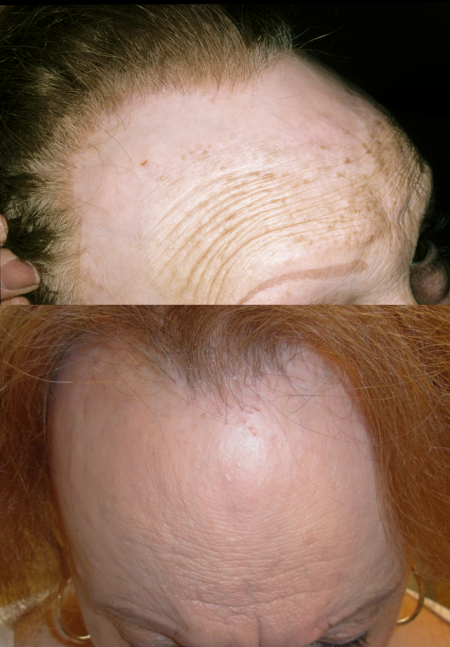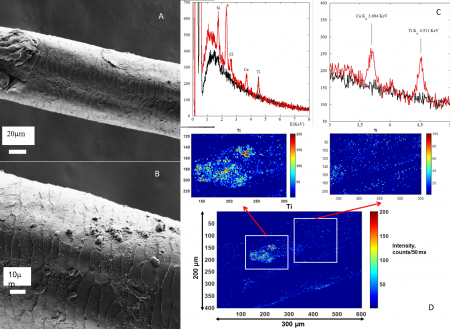Frontal fibrosing alopecia (FFA) is a pathology that was first described twenty years ago. It is characterized in particular by cicatricial alopecia on the frontal zone of the scalp and mainly affects postmenopausal women. Its origin is unknown, but the number of cases continues to increase, indicating perhaps the implication of yet unidentified environmental factors.
Dermatologists from the Bichat and Rothschild Hospitals have, for the first time, observed the presence of nanoparticles of titanium dioxide (TiO2) along the hair follicles of a patient presenting FFA who has been using sunscreens containing TiO2 on a daily basis for 15 years.
The analyses were carried out by scanning electron microscopy (SEM), and scanning X-ray fluorescence microscopy at the NANOSCOPIUM beamline.
Initially, a nanoparticle search was performed with scanning electron microscopy coupled with Energy-dispersive X-ray spectroscopy (EDX), carried out at Orsay, at the Laboratoire de Physique des Solides, on hair follicles extracted from the FFA affected zone in a patient (Figure 1). Micrometer scale abnormal deposits were observed along the hair follicle; their analysis revealed that they contained titanium.

Fiigure 1: Typical frontal fibrosing alopecia characterized by a hairline regression associated with eyebrows loss.
To refine these results, the particles were studied by fluorescence spectroscopy using a nanoscale X-ray beam (300 x 300 nm2) at the NANOSCOPIUM beamline of Synchrotron SOLEIL, in order to obtain element maps of several zones of these particles.
Along the surface of the follicles, aggregates of TiO2 microparticles (0.5 - 1 μm) associated with TiO2 nanoparticles were evidenced.

Figure 2:
Conventional SEM images of a patient’s plucked hair showing the presence of micrometer scale abnormal deposits (2A, 2B). The EDX data (black support, red abnormal deposit) identifies the presence of Silicon (EKα=1.740 KeV), Sulphur (EKα=2.305 KeV), Chlorine (EKα=2.622 KeV), Ca (EKα=3.694 KeV) and Titanium (EKα=4.511 KeV) in the abnormal deposit present at the hair surface (2C). X-ray fluorescence microscopy (NANOSCOPIUM): high 500 nm resolution distribution maps of Ti within the two measured hair samples (2D).
TiO2 nanoparticle influence
The patient reported that she has been using sunscreen containing titanium dioxide for 15 years. TiO2 is the most widely used white pigment. It is found in a large number of products: paint, building materials, food (sweets, biscuits...), pharmaceuticals (capsule shells, toothpaste...) but also cosmetics: creams and sunscreens due to its UV blocking properties.
The potential toxicity of TiO2 is currently a major public health concern - TiO2 has been classified by the International Agency for Research on Cancer (IARC) as a Group 2B carcinogen ("possibly carcinogenic to humans") - see also news at DIFFABS - and the long-term dermatological impact of these particles in humans is not yet well known.
The hypothesis formulated by the researchers is that the presence of titanium dioxide in the hair follicle "bulb" (zone rich in stem cells) is responsible for a so-called "lichenoid" reaction. These reactions, described with other metals such as nickel, correspond to an abnormal presence of T-cells in this area, resulting in the destruction of hair follicle cells.
Dynamic studies on hair follicles extracted after application of cream containing TiO2, with measurement of nanoparticles on different parts of the follicles, as well as more detailed analyses to characterize the exact location of the nanoparticles will be required to confirm the potential link between FFA and TiO2 nanoparticles.
These results are in press and were recognized with the Award of the Best Poster in the French Society of Dermatology congress, December 2017.
